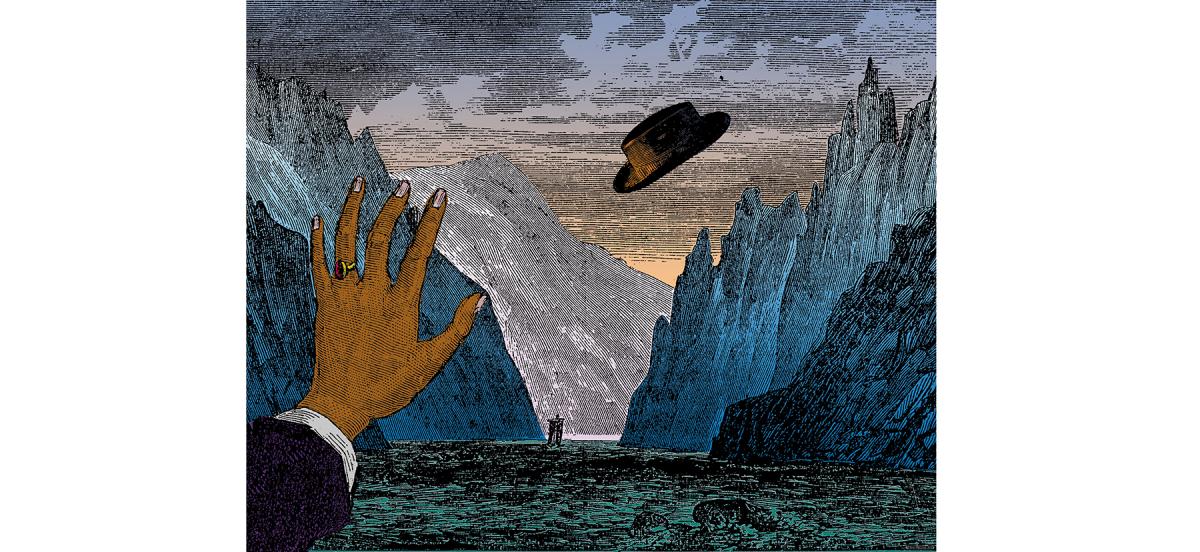Eric Edelman ’81 Finds Artistic Inspiration in the Unassuming

Eric Edelman's piece "Goodbye Pork Pie Hat."
Details
The sculptor and animator works with found objects to turn the everyday into the masterful.
Eric Edelman ’81 does not leave home without his notebook. The moment the New York-based collage artist and found-object sculptor encounters a source of inspiration—an interesting pattern, architectural feature, or element of nature—he writes it down or makes a little sketch to keep it from slipping his mind.
"Imagination doesn’t consist of coming up with ideas out of nothing,” says Edelman, who also uses the camera on his smartphone as a visual note-taking device. “Creativity arises from influences around us. I’m like a radio receiver taking in signals from the outside.”
Edelman works in many mediums, from dollhouses to origami to constructions in bottles. But collage has long consumed the majority of his attention; his mother and grandmother used to reminisce about a fascination with paper he developed while still in a crib, and he has always been intrigued by the idea of refashioning pre-existing images into something new. His pieces have been featured in solo shows, group exhibitions, and several publications, including The New York Review of Books, for which he has created a string of custom illustrations.
One place you won’t find his creations on display? His apartment. “Judgment of my own art is a destructive tendency that could immobilize me from doing other work. I pay as little attention to my past work as possible, unless I’m looking to it for guidance in moving forward,” he says.
No single theme dominates Edelman’s body of work, but he frequently incorporates images of 18th- and 19th-century wood engravings. He traces this attraction back to age six, when he watched The Fabulous World of Jules Verne, a 1958 Czechoslovakian science fiction film with a unique visual style in which the Victorian line engravings from Verne’s original novels are layered over the scenes.
These days, Edelman primarily creates his collages in digital form, which allows him to maximize his time—a necessity because he has held a series of more traditional jobs, usually in retail trades, in addition to working as an artist. Collaging on a computer rather than by hand shaves time off completion of a project and has helped him enhance his work with animation. In recent years, he has added the design of GIFs (Graphics Interchange Format files—essentially digitally animated stickers) to his repertoire.
Working digitally also makes it easy to collaborate with other artists. “I do not feel a sense of ownership of my work and noticed early on that I was reluctant to sign it,” says Edelman. “I welcome others’ influence, because art is a joint possession. Whatever source provided my inspiration is already a collaborator, anyway.”
Edelman’s latest collaboration involves poet Marc Zegans ’83. The two have remained close since they were students at the College and partnered on a theatrical presentation of Zegans’ project The Typewriter Underground, which involves what Edelman calls “a diverse group of eccentrics united by their love of—and struggles to preserve and share—typewriters and the obsolete medium of typewriting.” The piece, which premiered at the Henry Miller Library in Big Sur, in Northern California, on June 15, integrates film, live music, dance, and staged readings. Edelman, who has been crafting collages based on The Typewriter Underground since Zegans began the project, also created two of the animated video sequences that play in the background during the production.
Edelman says he is grateful for the opportunity to work with Zegans, whose writing ranks high among his countless muses. “So much influence surrounds us every day, it’s as though life happens in an open-air museum,” he says. “Inspiration is available to everyone. Creativity is about attitude and receptivity more than innate skill.”



